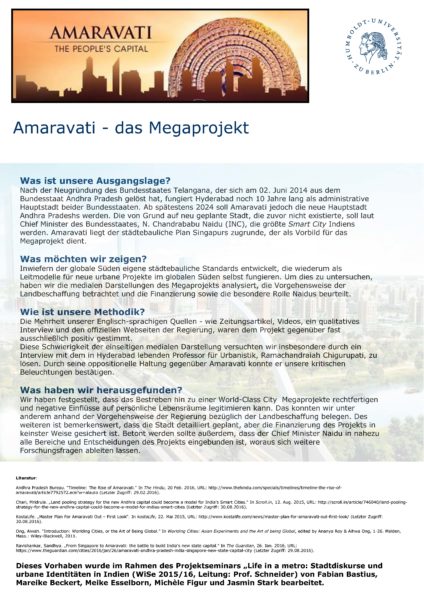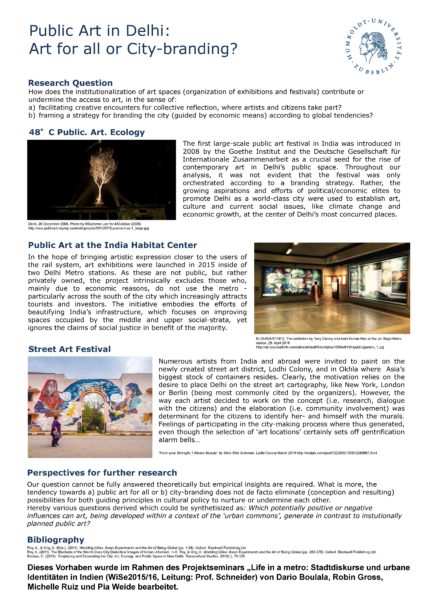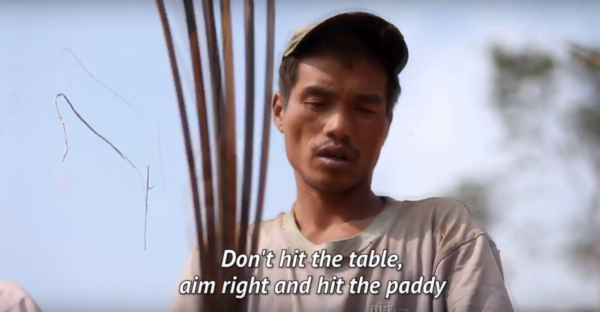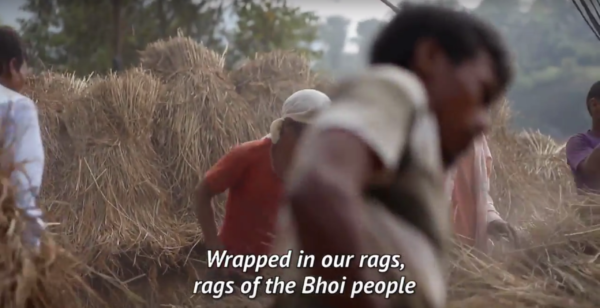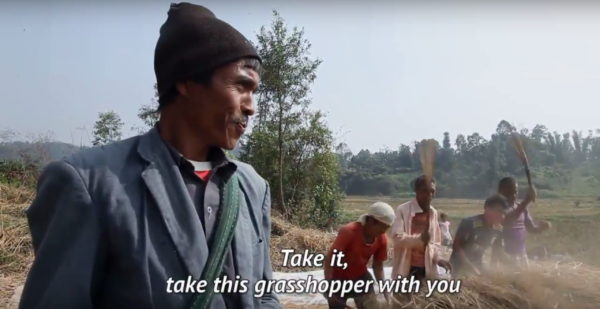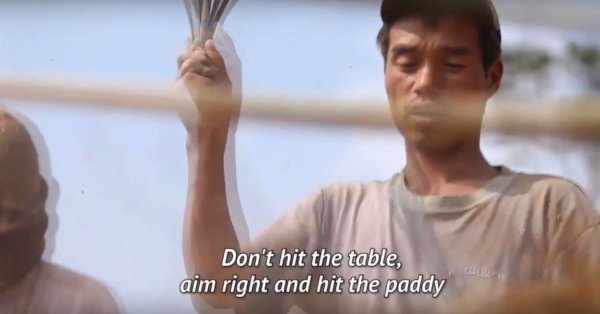Max Arne Kramer
Brief Life of Insects, Escaping Museums – Lak(h)empong Diaries, Sounds from the Truck Country and Kings Have Their Resorts, People Have Their Songs. These four titles of a series of six documentary films make you instantly wonder what may hold them together. Looking for orientation you could read the title of the film-series again – Songs to Live By – and perhaps find a synopsis saying that the films are dealing with indigenous communities in the North East of India. Perhaps you are even more puzzled now by the range of associations from fauna via commerce to state-institutions.
In some ways this series is an exploration of a new form of documentary by Shillong based Hindi poet, filmmaker and editor Tarun Bhartiya. His former filmic engagements include When the Hens Crow (2013) and Darjeeling Himalayan Railway (2010). He won the Indian National Film Award in editing for his work In Camera (2009). The two films he edited for Sanjay Kak Jashn-e-Azadi (2007) and Red Ants Dream (2013) are significant contributions to a cinema of resistance against the state driven violence in Kashmir and in the jungles of Odisha. Both films show a highly contextualized variation between ‚distancing effects’ and more realist representations of political struggle.
With the series on the North-East Bhartiya is exploring new grounds, both formally and in terms of a politics of representation. The titles already suggest that the series produced by the Meghalay Government Department of Arts and Culture is in some ways neither about art nor about culture. At least not in the way most of us would imagine a film to be about a culture or about a form of art. We may more fruitfully engage with this series as an attempt to take a close look at various song-performances and what they tell us about history, memory, power, and social transformation.
The songs seem to be part of a fragile memory that is fading in the rapidly changing societies of the North East. To give one example from the first film of the series „The Brief Life of Insects“. The farmer and musician Albinus Karkongor cannot remember a song he sang threshing paddy just a few months after the filmmaker captured a first performance of the paddy-song and asked him to sing it again for the camera. Even a recording that Bhartiya has done with his mobile phone was of no help to make Albinus remember the lyrics. The song was embedded into a bodily memory of the work on the field which is beautifully captured by the camera and the editing evoking the rhythm of the threshing while portraying the dynamics of the collective work.
In the last film of the cycle „Kings Have Their Resorts, People Have Their Songs“ the song Long Hai was restaged partly for the camera. A woman from Syndai asks: How can we preserve the song if we don’t cultivate millet. A voice from the side of the camera (perhaps the filmmaker) answers: You don’t have to actually cultivate millet. The song or tradition that has faded or is about to fade opens up questions of archive and preservation: who is recording for whom? Since hardly any written source exists in these oral traditions one further question becomes particularly interesting: what is the role of documentary film as an archive of these practices?
All films of the series are formally invested in the multi-sensorial experiences which go into the collective performances of these mostly work-related songs. There is the constant strive for gathering a sensibility not only of the particular – and sometimes lost – ritual context, but also of the films entanglement in the actualities that are produced through the camera. These interventions of the filmmaker are marked through subtle editing strategies that suggest how the presence of the film team re-invoked a ritual context gone by.
While the ritual setting of the Long Hai song was dependent on the harvest of millet, we see a group of women and men discussing how difficult it would be to re-stage this tradition in a time where betel nuts are produced for profit in Syndai. A telephone call from Shillong, the capital of Meghalaya, is signalling the distance of the filmmaker from the everyday context of Syndai and his interest to record something that is no longer practiced. However, some voices in his films make clear that what is gone is an absence that is felt as a lack. The new betel work has suspended a system of voluntary exchange of labour that has been central to the meaning of Long Hai. The films point towards a number of processes of commodification that have transformed the basis of living amongst the communities.
I understand this as the intervention of the filmmaker into a fragile memory. The camera gets entangled in the collective desire to restage something that is lost. But that ‘something’ is not framed within the familiar notion of culture as the way of life of a classifiable group. Instead, Bhartiyas films mobilise a lack from with-out by articulating an aesthetic potential of communality in a sceptical and always curious voice.
The titles of the films are:
- BRIEF LIFE OF INSECTS
22 mins | Ktien Nongtung with English subtitles
- LOVE SONGS OF SOTJAK AND RINGJENG
17 mins | A.chik with English subtitles
- ESCAPING MUSEUMS – LAK(H)EMPONG DIARIES
29 mins | Ktien Nongtung and Sohra Khasi with English subtitles
- SONGS & SECRETS IN SADOLPARA
20 mins | A.chik with English subtitles
- SOUNDS FROM THE TRUCK COUNTRY
39 mins | Pnar with English subtitles
- KINGS HAVE THEIR RESORTS, PEOPLE HAVE THEIR SONGS
40 mins | War Jaintia & Pnar with English subtitles
Nina Khan (HU Berlin) und Menusha de Silva (National University of Singapore) im Rahmen des Trouble Shooting Lab der Konferenz „Diversity Encounters. Intersectional and Post-Colonial Perspectives“, 24.-26. Mai 2016, Humboldt-Universität zu Berlin und National University of Singapore (NUS)
The joint conference dealt with the impact migrants make on the multicultural and multiracial dimensions of cities in Asia and Europe. Criticizing the East-West divide and the focus on ‘difference’ and ‘otherness’ in otherwise insightful academic publications on this matter, the conference aimed at developing a collaborative perspective by bringing together researchers from the East (NUS) and the West (HU Berlin) for reflecting and discussing each other’s research. This exchange was especially evident in the “Trouble Shooting Lab” for which three tandems were created, consisting of one PhD student from HU Berlin and one from NUS in each case. They exchanged information about their research and prepared a joint paper on common challenges in their projects and on how they could learn from each other’s case study.
In their presentation, Nina Khan and Menusha de Silva gave a short introduction to their respective research projects, highlighted the commonality in their studies and discussed some methodological challenges.
Menusha de Silva’s work examines the migration histories of retired Sri Lankan immigrants in the UK, their experiences of return to Sri Lanka for retirement, and the manner they negotiate their dual entitlements (mostly through dual citizenship) and sense of belonging in two countries in order create an ideal transnational retirement. Nina Khan’s research focuses on the “New Donor” India or rather “development partner”, as it prefers to be called, and its development discourse in particular. Against the background of India’s own experience as a recipient country and a former colonized country of the Global South, the question arises how this might impact its development discourse and whether this will form an alternative to the (until today) hierarchical western development discourse.
The common ground of these two research projects is the postcolonial lens. The key angle which is being taking is how today’s perspectives and knowledge of the world are still influenced by colonial time discourses of the North-South binary. We tried to reflect on how the Asian and European gaze is inherent in both ours studies. Considering the European gaze in Menusha de Silva’s work, most of the retired migrants interviewed shared the manner their encounters with the predominantly-White population in the UK made them aware of their inferior social location. Regarding the Asian gaze on the other hand, the migrants who returned to Sri Lanka for retirement experienced negative encounters with the culturally and religiously similar local population. These exclusions are due to the disparity between their transnational identities and the Sri Lankan society’s notion of the national subject. In Nina Khan’s study, India challenges the Western gaze on the South, which is still inherent in today’s dominant development discourse. It questions the dominant European (or rather Western) gaze or discourse and the binary of the giving, charitable and progressive North and the needy, receiving and “backward” South. By focusing on India’s donor status, the research intends to move away from the stereotypical portrayal of India as the “underdeveloped” recipient country in development cooperation.
The discussion on methodological challenges revolved around how the respective positionality as a student from a European/Asian academic institution (or traditional Western donor country) might influence the openness of interview partners. For example, a large proportion of retired migrants living in Sri Lanka conveyed their distrust of Western institutions, which they perceived to be circulating negative views of Sri Lanka. Within this background, the affiliation to a non-Western university was viewed as a neutral position by the participants and enabled a greater level of trust. Depending on the status of the interview partners (retired migrants, Indian government officials) and the larger context of the research, this positionality might have a positive or negative impact on the interview outcomes.
Given the nature of our individual researches, we highlighted that learning from the Asian and European context is a fruitful lens not just for studies that are explicitly situated in these regions, but also in researches where the Asian and European contexts are more nuanced.
Report by Mette Gabler
The 10th European PhD workshop in South Asian Studies was held June 17-19, 2016 outside Lisbon, Portugal, inviting a small group of PhD students affiliated with various universities around Europe to present and discuss current questions and ideas relevant to their theses. This annual workshop, organised by the European Association for South Asian Studies (EASAS), was hosted by the Centre for International Studies (CEI) at the University Institute of Lisbon (ISCTE), and provided stay for 18 PhD students and five senior scholars at the Inatel Oeiras, a resort by the river Tagus, 20 minutes away from Lisbon by train.
Following the thought behind EASAS, an academic association engaged in the support of research and teaching concerning South Asia in all fields of study and with the objective to promote South Asian Studies in all countries of Europe, the participants belonged to a range of disciplines. Among them anthropology, philology, history of literary or theatre, sociology, conflict management and development, economy, history and biomedicine, which provided not only broad discussions but insights from various perspectives. This lead to rich debates on topics as diverse as analysing Puranic texts, Marathi Literature during colonial times, and recent Hindi novels, investigating gender dynamics in health care, ethnographic studies on migration in Bangladesh and refugees from African countries in Delhi, as well as discussions on Malayalam cinema, advertising, and Parsi theatre.
The three day workshop was organised by Rosa Maria Perez and Jason Fernandes affiliated with the University Institute of Lisbon, and main commentators included Rosa Maria Perez herself, Alessandra Consolaro (University of Turin), Roger Jeffrey (University of Edinburgh) and José Mapril (New University of Lisbon). The papers that were circulated before the workshop were divided among them for an initial comment, followed by discussions among all participants.
The weekend began with an afternoon program of four papers but left ample time for informal discussions and connecting to PhD students currently situated across Europe; many also with ties to universities in South Asia. Also Saturday brought a full schedule and the engagement with the different topics continued outside the formal sessions. I left after another round of five papers on Sunday with affirmative impressions of meeting interesting people, thoughtful insights and useful comments.
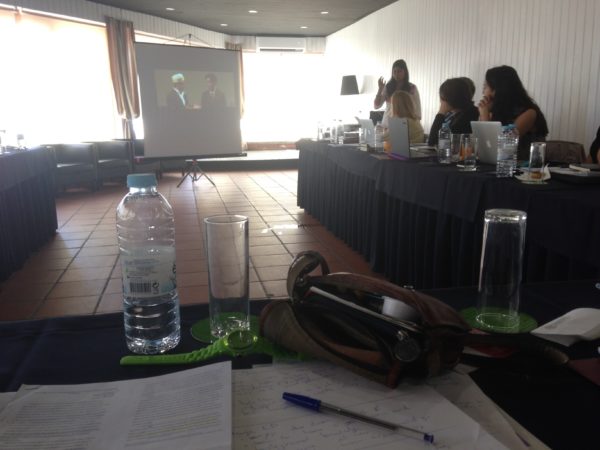
Photograph by Mette Gabler: Manju E P affiliated with Freie Universität, Berlin showing a clip form a Malayalm film in connection with discussing the paper: “Cinema within Cinema: Self-Refelctive/Self-Erasing Nature of Malayalam Cinema”.
Seonyoung Seo und Sebastian Sons
Im Rahmen der von der Humboldt-Universität zu Berlin in Zusammenarbeit mit der University of Singapore vom 24.-26. Mai 2016 organisierten Konferenz „Diversity Encounters: Intersectional and post-colonial perspectives“ präsentierte Sebastian Sons, Doktorand bei Frau Prof. Dr. Nadja-Christina Schneider, gemeinsam mit der Doktorandin Seonyoung Seo von der Universität aus Singapur Teile seiner Forschungsergebnisse. Beide nahmen an den so genannten „Trouble Shooting Labs“ teil, in denen jeweils ein Doktorand aus Deutschland sowie aus Singapur in intensiven Vorarbeiten Gemeinsamkeiten und Unterschiede ihrer Forschungsprojekte erarbeiteten und diskutierten. Vor allem methodische Herangehensweisen, theoriebezogene und empirische Herausforderungen und Erfahrungen wurden evaluiert. Während sich Sebastian in seiner Dissertation mit den Mediendiskursen um pakistanische Arbeitsmigrant_innen nach Saudi-Arabien beschäftigt, forscht Seonyoung zu nepalesischen Migrant_innen in Südkorea. In beiden Projekten nehmen der Zugang zu Eliten und der öffentliche Diskurs über das Phänomen Migration eine signifikante Bedeutung ein, wenngleich sich die methodische Herangehensweise und die lokalen Gegebenheiten doch deutlich voneinander unterscheiden. Beide Studien widmen sich der zeitgenössischen Diskussion um Arbeitsmigration, die in den Projekten als historisch bedeutsame Form der Mobilität und der transkulturellen Verknüpfung in Asien und dem Nahen und Mittleren Osten definiert wird. Basierend auf dieser Ausgangsthese analysieren beide Wissenschaftler die Auswirkungen der Migrationssysteme in den Aufnahmeländern Korea und Saudi-Arabien sowie in den Entsendeländern Nepal und Pakistan.
Daraus ergaben sich in der Diskussion einige signifikante Überschneidungen und Unterschiede in der Forschungsarbeit: Beide Projekte widmen sich Fragen nach Identitätskonstruktionen von Diasporagesellschaften, transnationalen und transkulturellen Netzwerken zwischen Empfänger- und Entsendeländern sowie dem Einfluss von Migration auf die jeweiligen Heimatländer. Während Sebastian die strategischen Ansätze, die Inhalte sowie die Debatten der jeweiligen Medienakteure über Migration wie Vertreter der Zivilgesellschaft und Journalisten analysiert, vertieft sich Seonyoung in ihrer Arbeit mehr darauf, die Selbstdefinition der nepalesischen Migrant_innen in Korea herauszuarbeiten und beschäftigt sich mit deren multiplen transnationalen Zugehörigkeiten, ihren unterschiedlichen kulturellen Affinitäten und ihren daraus erwachsenen hybriden Identitäten. Damit tragen beide Wissenschaftler zur akademischen Diskussion um sozialen Wandel in Zeiten der Globalisierung bei, in denen die Auffassung des Containerdenkens in nationalstaatlichen Kontexten zunehmend obsolet geworden ist.
Für beide Nachwuchswissenschaftler entwickelte sich aus den vorbereitenden Gesprächen und der gemeinsamen Präsentation eine intensive und konstruktive Diskussion, in der wesentliche Forschungsparallelen bei Fragen der Netzwerkbildung, Interviewführung und Öffentlichkeit trotz der verschiedenen regionalen Kontexte festgestellt wurden. Seonyoung und Sebastian empfanden die Mitwirkung am Trouble Shooting Lab als eine neue Forschungserfahrung, um die Kontakte mit anderen Wissenschaftlern zu intensivieren, neue Perspektiven zu erlangen und sich über Gemeinsamkeiten und Unterschiede in der täglichen Arbeit auszutauschen.
B.A. Arbeit von Janis Jirotka
28.06.2015
Erstgutachterin: Prof. Dr. Nadja-Christina Schneider
Zweitgutachterin: Dr. Pepetual Mforbe Chiangong
Abstract
‘Performing other (hi)stories’ has several dimensions of meaning. Positioned outside of na- tional narratives and historiographies, the histories of migrants and refugees are rendered invisible if they are not attached to a national framework of belonging. At the same time, the individual who is marked as the refugee, becomes the Other, the culturally unsuitable and the hyper-visible foreign. Of course, these life stories take place, even if they are ‘invisible’ to the public eye of an as homogeneous imagined community. Performing other (hi)stories can also mean a disruption of established discourses through the act of speaking out publicly and on stage in a bid to claim cultural self-representation; an act which holds a deep political connotation.
The actors we see on stage performing monologues of asylum are no refugees. They, as part of the citizen-nation-state construct, are performing other stories. The voices of refugees are transported through the bodies of the performers. Questions of identification, representation, ownership and moral responsibility arise through the performance of someone else’s narrative. However, reflecting on the refugee in a transit position rather than as a life in status quo, can help us understand why it is important that the individuals concerned are able to move forward with their lives.
Leseprobe und Inhaltsverzeichnis
Film review by Salma Siddique
In the summer of 2014, I casually browsed through the Bollywood section at a DVD rental shop in Innsbrucker Platz. The selection seemed mostly governed by one factor, Shah Rukh Khan. Every film starring the actor in a lead role in the last two decades was in the collection, including a highly-forgettable Shakti (2002). Given Deutschland’s demonstrable love for the indefatigable star, I certainly expected more than fourteen people – eleven women and three men – in a Wedding Kino for the last day, last show of Fan (2016) this spring in Berlin. Perhaps SRK’s transnational fans thought it too early to take their heads out after the recent sandstorm Dilwale (2015).
https://www.youtube.com/watch?v=nkS_Ar0Yad0
Fan dramatically explores the all-consuming passion of an obsessed fan whose star-worship acquires a stalking, destructive hue after being ‘spurned’ by his screen idol. Twenty-five-year-old Gaurav Channa runs an Internet café in (what is implicitly a refugee colony of) New Delhi and bears an uncanny resemblance to the film star Aryan Khanna, both roles played by a fifty-year-old Shah Rukh Khan. Mostly content with imitating Aryan at local events and staring agog at the star’s photographs plastered on the bedroom walls, Gaurav dreams of meeting the star someday even if for five minutes. When he wins a cash prize at a neighbourhood talent night, which involves performing an Aryan routine, Gaurav decides to go to Bombay just like Aryan did many years ago: without a train ticket and checking into the same hotel room. Things take an awry turn when Gaurav threatens an upcoming star, who has been at loggerheads with Aryan Khanna. Instead of acknowledging Gaurav’s devotion and agreeing to grant him a rendezvous, Khanna distances himself from this fan and reports him to the police. Gaurav is more broken by his idol’s betrayal than the beating he receives in police custody. What follows is his extended transnational revenge on the star, where deploying his facial and performative likeness, Gaurav delivers one iconoclastic blow after another to Aryan’s star image, forcing the star to pursue his fan across Dubrovnik and Delhi rooftops alike.
Outwardly self-reflexive about stardom and fandom with its numerous mise en abyme moments, Fan is hardly a first as far as takes on Shah Rukh’s stardom are concerned (Billu, Om Shanti Om) and is another addition to the spate of double/multiple roles (Duplicate, English Babu Desi Mem, Paheli, Om Shanti Om, Rab Ne Bana Di Jodi and Don). What is certainly unprecedented about Fan are its confrontations with the aging star body and refutation with technology and performance. If Khan’s body has been symbolic of irrepressible energy and stamina, it has also been a site of injuries and enduring pain. It is the play on the potential and limits of Khan’s star body that makes Fan fascinating. Gaurav Channa was achieved through a physical transformation of the star involving weight-reduction, prosthetic make-up as well as special effects that made the transformation seamless and creaseless. Yet despite physical and virtual prostheses, twenty-five-year-old Gaurav’s agile moves and sprints are infused with a kinesis and mobility that have been central to Shah Rukh Khan’s performance.
Fan is a rich film text (one where everyone will find what they are looking for!), most obviously a commentary on the egoistic twins of stardom and fandom. It has a strong queer subtext, foraging on Khan’s rumoured bisexuality. A real-life, though not psychotic, fan and lookalike Raju Rahikwar supposedly inspired it. Most significantly, however, as the film meditates on his early success as a deranged and homicidal lover, it also ends up defamiliarising Shah Rukh Khan: it is not the unstable fan but the star who is more unpredictable of the two. As the key referent of the film, ‘Shah Rukh Khan’ emerges more plastic and air-brushed than his youthful doppelganger. In its replications and prostheses, Fan splinters the very star image it ostensibly thrives on. As tempting as it is to read (and in some cases react to!) Fan as ‘a star in descent’ film, Gaurav’s restless energy and lithe body signal new possibilities for aging and star mystique in a world of virtual bodies and mobility. For those watching Shah Rukh, picture abhi baaki hai mere dost (The film is yet to finish, my friend)!

Einen „Städtetrip zur Kunstmetropole Neu-Delhi“ hat das Magazin Monopol in der Ausgabe vom 27. Januar 2016 veröffentlicht. Jamila Adeli beschreibt in ihrem sehr lesenswerten Artikel die Orte und Stadtviertel, in denen zeitgenöissche Kunst eine immer wichtigere Rolle im Stadtleben Delhis spielt. Ebenfalls in diesem Themenspezial enthalten: ein Interview mit dem für seine Graphic Novels bekannten Künstler Sarnath Banerjee und eine Liste mit wichtigen Kunstorten in Delhi.
Wichtiger Hinweis zu diesem Artikel:
Wertende Begriffe wie „Kunstschickeria“ wurden nicht von der Autorin selbst verwendet, sondern nachträglich durch die Monopol-Redaktion in ihren Text eingefügt und ohne Rücksprache mit der Verfasserin gedruckt – im Original hatte Jamila Adeli stattdessen den Begriff „Kunstszene“ verwendet.
Link zum Artikel-PDF:
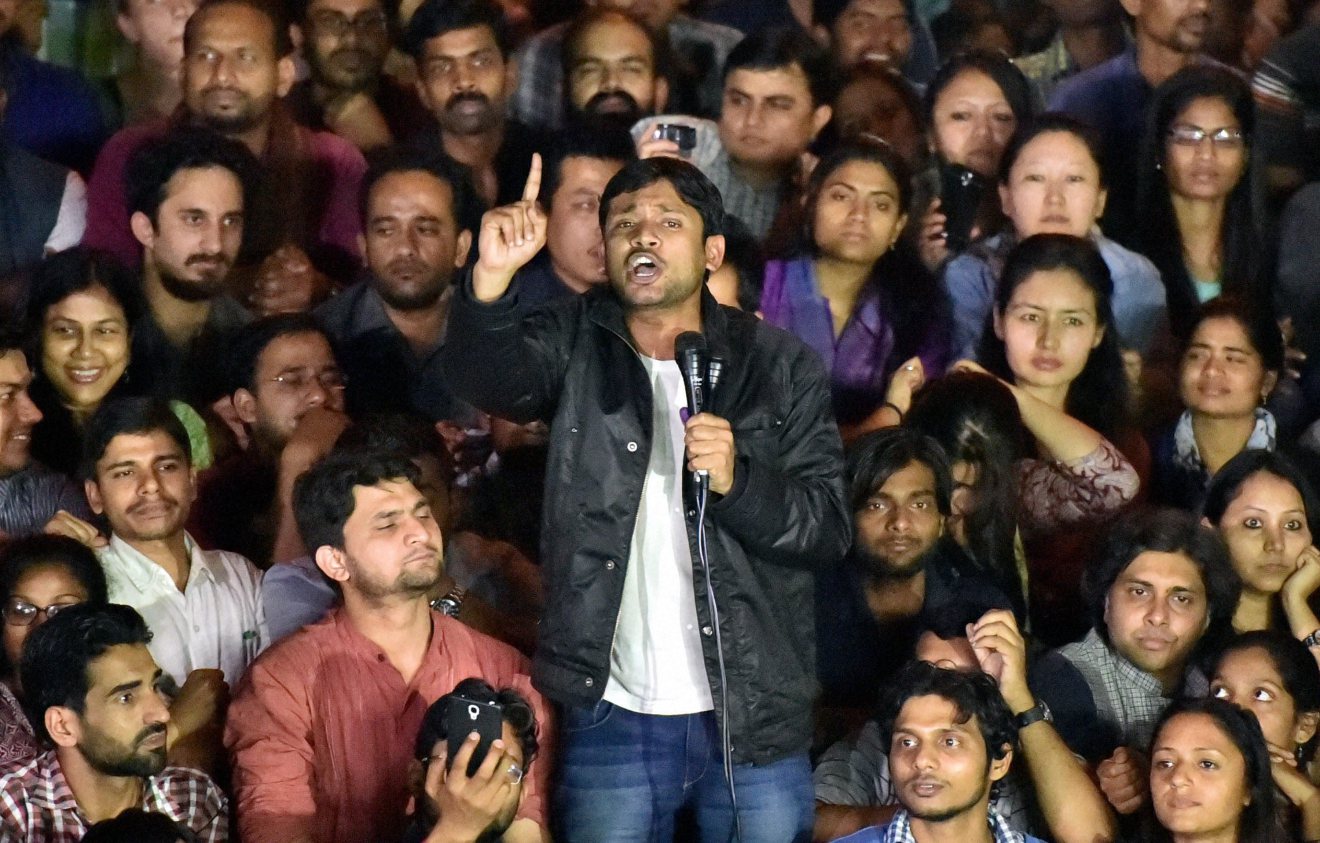
Ein Beitrag von Max Kramer
Die Studentenbewegung an indischen Hochschulen hat auf meiner Facebookseite einen Wirbelsturm an Debatten und Videos ausgelöst. Sie begann damit, dass in Reaktion auf einen nicht genehmigten Protest im Andenken an die kaschmirischen „Märtyrer“ Afzal Guru und Maqbool Bhat der Studentenführer der All India Student Federation, Kanhaiya Kumar, auf dem Campus der Jawaharlal Nehru University (JNU)in Neu-Delhi aufgrund von „sedition“ verhaftet wurde. „Sedition“ ist ein aus kolonialer Zeit stammender Begriff, der auf Deutsch Anstiftung zum Aufruhr bedeutet und zwischen Volksverhetzung und Hochverrat angesiedelt werden kann. Ursprünglich wurde das darauf bezogene Gesetz von den Briten angewandt, um indische Nationalisten wie Mahatma Gandhi von ihren politischen Kampagnen abzuhalten. Nach massiven internationalen Protesten, die sich um den Zustand der Demokratie und Redefreiheit in Indien drehten, wurde Kumar vor einigen Tagen wieder aus dem Gefängnis entlassen und hielt am 03. März eine Rede auf dem Campus der JNU. Diese knapp einstündige Rede auf Hindi/Urdu war eine rhetorische Meisterleistung. Sie begann und endete mit Slogans, die „Azadi“(Freiheit) von unterschiedlichsten Formen der Unterdrückung forderten: von der Kastenunterdrückung, von kapitalistischer Unterdrückung, von genderbezogener Unterdrückung usw. Dabei brachte er die politische Bewegung des Mitautoren der indischen Verfassung und Dalit-Anführers Bhimrao Ramji Ambedkar mit traditionelleren linken Ansätzen unter einen Hut. Er flocht fließend Wortspiele in seine Rede ein und berichtete von seinen „Erfahrungen im Gefängnis“, die er halbironisch als Solidaritätserlebnis mit den berüchtigten Polizisten Delhis schilderte. Schließlich seien er und sie aus der gleichen Klasse und an Solidarität fehle es vielleicht nur aufgrund von Übersetzungsschwierigkeiten. Ganz in diesem Sinne fordert er die JNU-Studenten auf, ihre theorielastige Sprache zu überdenken, da sie unter den Zielgruppen ihrer Politik, den Bauern, Armen und Ausgestoßenen schlecht verstanden werde. Kumars Rede macht momentan auf sozialen Netzwerken die Runde. Einige Kommentator_innen sehen mit Kumar einen neuen Stern am Himmel sozialer Bewegungen in Indien aufgehen.
Was ist aber dieses Wort „Azadi“ und wie steht es zu den jüngsten Ereignissen?
Kumar wurde nach einer Kundgebung von vorwiegend kaschmirischen Studierenden an der JNU verhaftet, die, wie schon viele Male zuvor, das Recht auf politische Selbstbestimmung der Region öffentlich eingefordert haben. „Politische Selbstbestimmung“ ist eine recht bekannte Bedeutung von Azadi, die offen lässt, ob es sich um einen Anschluss an Pakistan, um Separatismus oder, seltener, um eine kooperative Lösung handelt. Solche Proteste sind an der JNU Teil des universitären Alltags. Ich selbst war auf etlichen dieser Demonstrationen anwesend, ohne dass die Polizei eingeschritten wäre. Dieses Mal jedoch entschieden sich regierungsnahe Akteure, daraus ein Medienereignis zu machen. Dieses Ereignis war aus Regierungsperspektive vielleicht eher kontraproduktiv, wenn man bedenkt, was für eine neue Sichtbarkeit Kumar dadurch gewann. Der am stärksten kommentierte Satz aus Kumars Rede nimmt die begriffliche Problematik von Azadi auf. Er lautete „Bharat se nahin, Bharat mem azadi mang rahe hain“ („Wir fordern nicht die Freiheit von Indien, sondern in Indien“).Viele von meinen „Facebook-Freunden“ stammen aus dem Kaschmirtal und sind mit der JNU assoziiert. Die Rezeption von Kumars Rede beschäftigte sich daher oft mit Hindi-Postpositionen (im Hindi stehen die Verhältniswörter hinter dem Wort, auf das sie sich beziehen): was ist mit ‚mem‘ (in, innerhalb) und was ist mit ‚se‘ (getrennt, instrumental) gemeint? Zum ‚mem’ kann neben Kumars Rede auch auf die gleichzeitig in Reaktion auf die Ereignisse ins Leben gerufenen Teach-In-Vortragsreihe an der JNU über Nationalismus hingewiesen werden. Dort erkunden einige Professor_innen der Universität die Potentiale „inklusiver nationaler“ Artikulation, meist in Bezug auf die klassischen Kandidaten Rabindranath Tagore und Mahatma Gandhi. Für viele Student_innen aus dem Kaschmirtal bedeutet ‚mem‘ allerdings immer noch den Einschluss in die Union. Eine föderale Lösung geht ihnen nach mehr als 25 Jahren militärischer Besatzung nicht weit genug. Mohamad Junaid, Anthropologe und Absolvent der JNU, erinnert sich, dass der Begriff Azadi erst seit den frühen 2010er Jahren eine ganze Reihe linker Artikulationen verknüpfte. Daher die Ambivalenz im Umgang mit ‚mem‘ und ‚se‘. In der Imagination vieler nationalistisch denkender Menschen ist Azadi noch ausschließlich die Forderung einer „eigensinnigen, von Terroristen durchdrungenen“ Region. Die Forderung stellt für sie eine ständige Bedrohung nationaler Integrität dar. Für Studenten wie Kanhaiya Kumar und für viele Feminist_innen in Indien und Pakistan war Azadi allerdings schon länger ein bekannter Slogan, der dem Wunsch zur Freiheit die richtige emotionale Tonhöhe mitgibt. Dieses Potential von Azadi besteht nun im Verhältnis zu Kaschmir darin, Gemeinsamkeiten in der Opposition zu einem verantwortungslosen politischen System und sedimentierter sozialer Machtbeziehungen zu artikulieren, die bislang nur selten einen gemeinsamen Nenner fanden. Auch im Kaschmirtal wurde von der Bevölkerung ein eintägiger Streik als Zeichen der Solidarität mit den Student_innen der JNU abgehalten. Mohamad Junaid führt die demokratischen Potentiale aus, die aus der neuen Pluralität von Azadi-Forderungen folgen könnten:
„Our responsibility is not to divest azadi of its plural meanings, but to affirm them all together. The power of azadi chants on JNU’s campus does not lie in watering it down to make it acceptable to the nationalist, upper-caste Indian bourgeoisie. It lies in its plural expressions; however difficult those expressions might appear. It lies in articulating the struggle for Dalit liberation within the Kashmiri Tehreek [Bewegung], the Kashmiri Tehreek within the Dalit struggle (both of which have happened in their own way), and the students’ struggles within the other two. There is no ‘proper’ azadi, or ‘clarification’ azadi. What kind of azadi can a court or a constitution give which can’t bear even a few harmless slogans? In any case, what kind of azadi is it if it does not even commit to causing a little discomfort among the powerful?“
Allerdings mahnen einige meiner kaschmirischen Freunde zur Vorsicht, da ihre Forderungen nicht „einfach“ in etwas Größerem aufgehen. Sie möchten auch ernst genommen werden, wenn sie „se“ sagen. Damit begann schließlich das Medienereignis in der JNU und erst in einer Reaktion darauf formulierte Kumar das inklusive ‚mem‘ seiner Rede. Ein Freund von mir postete auf Facebook, dass er hofft, diese Aneignung von Azadi führe nicht in die erweiterten Postposition von ‚se pahle‘ (vorher) und ‚ke baad‘ (danach), so dass die möglichen Transformationen einer ‚indischen‘ Studentenbewegung offen bleiben. Zuletzt fällt mir dazu ein, dass „se“ schließlich auch als „instrumental“ verwendet werden kann: erst durch diese Transformation einer „indischen“ Wahrnehmung des leidenschaftlichen Appells von Azadi kann das von vielen Kaschmiris erträumte „se“ als eine Form der Trennung im Einverständnis möglich werden (und dann vielleicht schon nicht mehr nötig sein).
Quelle Bild: Kamal Singh
Weitere Artikel-Links zum Thema:
- Schauspielerin Kalki Koechlin löst Diskussion auf Twitter aus durch ihr Statement zur Politik der Postposition/Azaadi
- ‚Azaadi In Bharat‘: A New Anthem, A New Political Star? NDTV, March 4, 2016
Altersarmut in Indien
– Steven Herbig
 Hegemoniale Männlichkeit/Körper/Raum
Hegemoniale Männlichkeit/Körper/Raum
– Erik Becker
Desi-Sound und Bhangra-Beat
Herstellung und Verhandlung von
Dispora-Identität durch Musik
-Oskar Zoche
 Marriage Migration from Thailand to Germany
Marriage Migration from Thailand to Germany
Chances and Challenges after Migration
– Keerati Traitrong
Indians on TV: Challenging Hollywood’s
Characterization of South Asian (American)
Men and lack of diversity through Comedy
-Elena Ashly Dudel
 Urban Romancing in Dhaka –
Urban Romancing in Dhaka –
Wie junge Frauen den urbanen Raum nutzen
– Maike Lüssenhop
Transnational Retirement Migration
Movements to Thailand
-Nicola Steinigeweg
 Let’s talk about Sex…
Let’s talk about Sex…
Der Diskurs über den Umgang mit
Verhütungsmethoden in Indien
– Jasmin Bürkl
Kontrollierte Reproduktion (o)der
Sexualität?
-Liza Veldhuis



